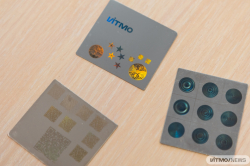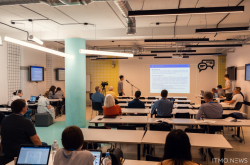How did you learn about the award?
By chance, my colleague sent me the link to the presidential decree published in the Poisk newspaper. This one is the fifth governmental award. It is very nice when your job is appreciated. But in fact, to receive an award is not the goal we work for. Humans constantly move forward – if one has conquered a peak, one wants to conquer the next. Having conquered the highest one, he or she wants to follow the hardest way.
How did you start your scientific career? Why did you choose laser technologies?
We were students during the Soviet period – back then our opportunities were limited. We could choose science or the industrial field. I graduated with honors – I always liked discovering something new.
When lasers were discovered, I was a fourth year student of St. Petersburg Electrotechnical University “LETI.” It was my luck that Konstantin Krylov headed the chair I graduated from – as a well-educated and creative specialist, he immediately understood the importance of lasers and then organized the first Soviet’s conference on quantum electronics at ITMO. Only ten people who dealt with this field visited it. But we translated all new articles devoted to lasers and exchanged ideas. After the invention of lasers we started our own activity. It seemed that lasers were all-powerful – and later one found the proof for that.
In two years after your graduation you established a laboratory for laser technologies despite the fact that back then it was a pioneering field.
After graduation, my colleagues and I got positions correlated with the degrees we had – nobody provided education programs devoted to lasers. However, those who visited these seminars, wanted to work only on laser technologies. We started our career at Svetlana Engineering Enterprise, which was the first organization in the Soviet Union that started developing microelectronics. One of our tasks was to make microscopic holes in ferrite plates, the size of 100 microns or even less. Back then one made these holes using ultrasound. We offered to use laser for this purpose.

Svetlana Engineering Enterprise
Philip Staros, the head of this organization, migrated from the USA because of Rosenberg Case. He permitted us to try and gave one year. My colleagues and I came to the State Optical Institute, where the first laser was built, and applied for the internship – we were working the whole summer without any rest to receive required information. In 1965, we successfully conducted the experiment. The same year we organized a lab at ITMO. Then, in the 1980s, the first Laser Technologies Department was established.
How do researchers do scientific discoveries? Is it true that some things are discovered by chance?
The most interesting discoveries were made instinctively. However, then one needed to work hard to comprehend and explain a phenomenon. One needs an idea, which comes unexpectedly. I’d like to give an example. In 1968, we discovered thermochemical laser processing. Now it is widespread, but over 50 years ago it was a new one – using this method one can limit the location of the chemical reaction. In other words, it gave an opportunity to localize a chemical reaction with laser, previously the reaction occurred everywhere or nowhere.
To make a photomask for a large integrated circuit, one needs to spend over a week for 37 various photolithography sessions. We tried to use laser ablation instead of this: one focuses a laser on a thin chrome film based on glass, then the substance vaporizes – it means that we can make an image by managing a laser beam.

Vadim Veiko receives the award
We analyzed the stages of ablation i.e. those capacity rates that are enough for ablation. We used the following strategy: we made a projection of the image as opposed to focusing it. At the beginning we had enough power but then we lacked it. There was no trace of vaporization. By chance, I looked at the detail under some angle and realized something like a dirty spot. I blew on it to erase the spot and unexpectedly saw a projection, which was invisible before. Then, when the wet steam went off, the projection became invisible again. I blew on the glass again and then I started doing it once a week – every time the image appeared when there was moisture and then disappeared.
At the same time we had other tasks, that is why two or three months had passed before we understood that various types of condensation mean that hydrophobic properties change. We assumed that this may be related to some chemical reaction. We asked our colleague who worked in a lab above ours. He recommended to put it in a chrome pickle solution. We did it, but nothing happened. It turned out that one had to use an aluminum catalyst – when we used a thin piece of aluminum wire, everything dissolved except the part we radiated.
Having checked this we came to the point that it was all about oxidation. That is how thermochemical laser processing was discovered. Later some researchers from Novosibirsk read our article devoted to this topic in the Proceedings of the USSR Academy of Sciences and then in the 1980s they constructed a ring oscillator for images. Before its creation one produced diffractive optical elements using a multiple stage method – it was necessary to use 12 devices including photomechanical and chemical ones as well as to provide photolithography. Now this process includes only one stage.

Steward Observatory
Using these devices researchers did some unique things. For instance, there was a project in alliance with Steward Observatory of the University of Arizona – it has the world’s largest binocular telescope, the diameter of each glass is 8.4 meters. It was necessary to use a huge optical system called zero correction to bring it to bear on a star. The system includes many elements; it is as large as a wardrobe. One developed a diffractive imitation of the star using the ring oscillator – a detail size of 20 cm is used nowadays instead of this system.
What are you working on these days?
My colleagues from Novosibirsk and I are working on a report on the fundamental project devoted to resolution enhancement. We explained this in theory, and then conducted an experiment, which proved that it is possible to create an image using thermochemical method as opposed to optical.
For instance, you can see two dots, if the distance between them is 0.6 light wavelength or more. If they are closer – it will be impossible to distinguish them. However, using thermochemical method, one can put them even closer – it is possible due to the higher resolution. It is a breakthrough! My colleagues from Novosibirsk and I have already won a grant by the Russian Scientific Foundation. Until now lithography was in a micron range. These days, it is in a nanometer range. Working on this project we aim to increase the resolution up to 100 nanometers.
Using this method one can create photomasks with higher resolution. We plan to reach a resolution equal to 13 nanometers – it is UV-radiation. We haven’t achieved it yet, but we plan to gain this in future.

The Order II Class "For Merit to the Fatherland"
What is your prediction of progress in the field of laser technologies?
Despite the economic recession of these days, the pace of growth in the field of lasers is stable. During the initial years of laser technologies, the growth was over 20-25% - now some types of laser also develop very fast. Thanks to new lasers, laser radiations and their applications, the process of growth will continue. According to the idea declared at a meeting of Nobel Prize winners at the beginning of the 21st century, lasers would be the main industrial tool instead a tool bit and milling cutter. This tendency works in automotive industry, shipbuilding and aerospace industry.
As of now, we are used to optical communications, using the word “optical” I also imply “laser.” Optical memory, optical computing machines are also on the agenda. However, I think that we will not focus on optical computing only – the future belongs to synthesis of technologies such as optoelectronics, magnetism and optics.
There will be no pivotal point – once we will find ourselves living in the new world surrounded by information technologies equipped with new elements.
Apart from science you are interested in climbing. How do you make time for this hobby?
It is impossible to be a researcher all around the clock. Sometimes you feel tired and need a break. For this purpose I have a hangboard in my office. Furthermore, rock climbing is my hobby since my student years. Every day after work I go to a climbing gym or swimming pool. In winter, I go skiing and run in summer.

Vadim Veiko
Do you come up with scientific ideas in the mountains? Or you can only focus on either hobby or sport?
When I visit a climbing gym I cannot think about anything except my activity. Usually ideas come during sleeping. When you are awake your mind criticizes all the ideas. When you sleep, your inner critic sleeps too – it is the very time for fresh ideas to appear.
There are special periods when you have to write down all new things. For this purpose my friend gave me a flashlight pen. I keep it and a piece of paper on my bedside table.
What are your plans related to conquering peaks?
Last summer I mounted the Kazbek. Moreover, I dream about conquering a peak nobody mounted before and then call it ITMO Peak – this idea occurred two years ago. In 2015 we found such on the Pamir Mountains but we didn’t mount it and decided to postpone this idea. We plan to do that this year, we already fixed the time – from July 15 to August 5.





